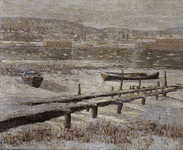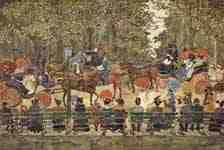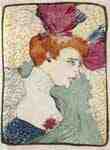Whitney Museum of American Art, New York

Winter on the River / Floating Ice / Snow Bound Boats, Ernest Lawson

Central Park, New York, Maurice Brazil Prendergast
 Marcelle Lender in » Chilpéric ", Henri de Toulouse-Lautre
Marcelle Lender in » Chilpéric ", Henri de Toulouse-Lautre
The Whitney Museum of American Art — known as "The Whitney" — is a New York City art museum with a focus on 20th- and 21st-century American art. It was founded in 1931 by Gertrude Vanderbilt Whitney (1875-1942), a wealthy and prominent American socialite and art patron.
The Whitney's permanent collection comprises more than 21,000 paintings, sculptures, drawings, prints, photographs, films, videos, and new media by more than 3,000 artists. It places a particular emphasis on exhibiting the work of living artists for its collection as well as maintaining an extensive permanent collection containing many important pieces from the first half of the last century. The museum's Annual and Biennial exhibitions have long been a venue for younger and less well-known artists whose work is showcased there.
From 1966 to 2014, the Whitney was located at 945 Madison Avenue at East 75th Street in Manhattan's Upper East Side. The museum closed in October 2014 to relocate to a new building designed by Renzo Piano located at 99 Gansevoort Street at Washington Street in the West Village/Meatpacking District neighborhoods of lower Manhattan; it reopened at the new location on May 1, 2015.
History
Early years
The Whitney's original location, at 8–12 West 8th Street, between Fifth Avenue and MacDougal Street in Greenwich Village
Gertrude Vanderbilt Whitney, the museum's namesake and founder, was herself a well-regarded sculptor as well as a serious art collector. As a patron of the arts, she had already achieved some success as the creator of the "Whitney Studio Club," a New York–based exhibition space which she created in 1918 to promote the works of avant-garde and unrecognized American artists. With the aid of her assistant, Juliana R. Force, Whitney had collected nearly 700 works of American art, which she offered to donate to the Metropolitan Museum of Art in 1929, but the museum declined the gift. This, along with the apparent preference for European modernism at the recently opened Museum of Modern Art, led Whitney to start her own museum, exclusively for American art, in 1929. Whitney Library archives from 1928 reveal that during this time the Studio Club utilized the gallery space of Wilhelmina Weber Furlong of the Art Students League to exhibit traveling shows featuring Modernist works.[1][2] In 1931, architect Noel L. Miller converted three row houses on West 8th Street in Greenwich Village – one of which had been the location of the "Studio Club" – to be the museum's home as well as a residence for Whitney.[3] Force became the first director of the museum, and under her guidance, the museum concentrated on displaying the works of new and contemporary American artists.[4]
In 1954, the museum left its original location[3] and moved to a small structure on 54th Street connected to and behind the Museum of Modern Art on 53rd Street. On April 15, 1958, a fire on the second floor of MOMA that killed one person forced the evacuation of paintings and staff on MOMA's upper floors to the Whitney. Among the paintings moved in the evacuation was Sunday Afternoon on the Island of La Grande Jatte which had been on loan from the Art Institute of Chicago.[5]
Move to the Upper East Side
The Whitney Museum of American Art's former (1966-2014) home on Madison Avenue. The Marcel Breuer-designed building will be leased by the Metropolitan Museum of Art beginning in 2015.
In 1961, the museum began seeking a site for a larger building. The Whitney settled in 1966 at the southeast corner of Madison Avenue at 75th Street in Manhattan's Upper East Side.[6] The building, planned and built 1963–1966 by Marcel Breuer and Hamilton P. Smith in a distinctively modern style, is easily distinguished from the neighboring townhouses by its staircase façade made from granite stones and its external upside-down windows. In 1967, Mauricio Lasansky showed The Nazi Drawings. The exhibition traveled to the Whitney Museum of American Art in New York, where they appeared with shows by Louise Nevelson and Andrew Wyeth as the first exhibits installed in the new museum.
However, the institution grappled with space problems for decades.[7] From 1973 to 1983 the Whitney operated its first branch at 55 Water Street, in a building owned by Harold Uris who gave the museum a lease for $1 a year. In 1983 Philip Morris installed a Whitney branch in the lobby of its Park Avenue headquarters. In 1981 the museum opened an exhibition space in Stamford, Connecticut, that was housed in Champion International Corporation.[8] In the late 1980s, the Whitney entered into arrangements with Park Tower Realty, I.B.M. and the The Equitable Life Assurance Society of the United States, setting up satellite museums with rotating exhibitions in the lobbies of their buildings.[9] Each museum had its own director, and all plans were to be approved by a Whitney committee.[8]
The institution has tried to expand its landmark building and in 1978 commissioned UK architects Derek Walker and Norman Foster to design a tall tower alongside, the first of several proposals from leading architects. But each time the effort was abandoned, either because of the cost or the design or both.[7] In order to secure additional space for the museum’s collections, then-director Thomas N. Armstrong III developed plans for a 10-story, $37.5-million addition to the Whitney’s main building. The proposed addition, designed by Michael Graves and announced in 1985, drew immediate opposition. Graves had proposed demolishing the flanking brownstones down to the East 74th Street corner for a complementary addition. After the project gradually lost the support of many of the museum’s trustees, the plans were dropped in 1989.[10] Between 1995 and 1998, the building underwent a renovation and addition by Richard Gluckman. In 2001, Rem Koolhaas was commissioned to submit two designs for a $200 million expansion; plans were dropped again in 2003,[11] causing director Maxwell L. Anderson to resign.[12] New York restaurateur Danny Meyer opened Untitled, a restaurant in the museum in March 2011. The space was designed by the Rockwell Group.[13]
Move downtown
Gansevoort Street location under construction, 2014
The Whitney developed a new main building, designed by Renzo Piano, in the West Village and Meatpacking District sections of lower Manhattan. The new museum, located at the intersection of Gansevoort and Washington Streets, was built on a previously city-owned site and marks the southern entrance to the High Line park.[7] Construction began in 2010 and was completed in 2015.[6] The construction was $422 million.[14]
The new structure spans 200,000 square feet (19,000 m2) and nine stories that include the city's largest column-free art gallery spaces, an education center, theater, a conservation lab and a library and reading rooms. Two of the floors are fully devoted to the museum's permanent collection.[15] The only permanent artwork commissioned for the site—its four main elevators—were conceived by Richard Artschwager.[16] The new building's collection comprises over 600 works by over 400 artists.[17]
The new building is much more expansive and open than the old ones.[18] As one New York Times review described the building:
The Whitney ... has a series of events spaces at its margins: a flexible auditorium and four large terraces, three of which are linked by an outdoor staircase. ... It has timed tickets that are designed to control crowding, but people may linger longer than expected. After art they can retire to the eighth-floor cafe, the terraces or the lines of comfy leather couches facing glass walls overlooking the Hudson and Greenwich Village at either end of the fifth floor.[17]
The museum says it needs to raise $760 million for the building and its endowment. In May 2011, the Metropolitan Museum of Art announced it had entered into an agreement to occupy the Madison Avenue building for at least eight years starting in 2015, easing the Whitney of the burden of having to finance two large museum spaces.[19]
After an April 30, 2015, ceremonial ribbon cutting attended by Michelle Obama and Bill de Blasio,[17] the new building opened on May 1, 2015.[20]
Collection
Gertrude Vanderbilt Whitney by Robert Henri (1916)
The museum displays paintings, drawings, prints, sculptures, installation art, video, and photography. Every two years, the museum hosts the Whitney Biennial, an international art show which displays many lesser-known artists new to the American art scene. It has displayed works by many notable artists, and has featured unconventional works such as a 1976 exhibit of live body builders, featuring Arnold Schwarzenegger.[21]
The original 600 works in the permanent collection grew to about 1,300 by 1954 when the second Museum building opened, and to approximately 2,000 with the opening of the Breuer building in 1966. Today the permanent collection contains more than 18,000 works of art from many renowned artists. Artists represented include Josef Albers, Donald Baechler, Thomas Hart Benton, Lucile Blanch, Louise Bourgeois, Charles Burchfield, Alexander Calder, Ching Ho Cheng, Dan Christensen, Greg Colson, Ronald Davis, Stuart Davis, Richard Diebenkorn, Arthur Dove, William Eggleston, Helen Frankenthaler, Arshile Gorky, Keith Haring, Grace Hartigan, Marsden Hartley, Robert Henri, Eva Hesse, Hans Hofmann, Edward Hopper, Jasper Johns, Franz Kline, Willem de Kooning, Lee Krasner, Ronnie Landfield, John Marin, Knox Martin, John McCracken, John McLaughlin, Robert Motherwell, Bruce Nauman, Louise Nevelson, Barnett Newman, Kenneth Noland, Paul Pfeiffer, Jackson Pollock, Larry Poons, Maurice Prendergast, Kenneth Price, Robert Rauschenberg, Man Ray, Mark Rothko, Morgan Russell, Albert Pinkham Ryder, Cindy Sherman, John Sloan, Andy Warhol, and hundreds of others. A photography collection was begun in 1991.
In addition to its traditional collection the Whitney has a website, called Artport, that features "Net Art" that changes monthly. The Whitney Museum of American Art will not sell any work by a living artist because it could damage that artist’s career. But it will trade a living artist’s work for another piece by the same artist.[22]
Library
The Frances Mulhall Achilles Library is a research library originally built on the collections of books and papers of founder Gertrude Vanderbilt Whitney, and the Whitney Museum’s first director, Juliana Force. The Library currently operates in the West Chelsea area of New York City.[23] The Library in West Chelsea contains Special Collections, and the Whitney Museum Archives. The Whitney Museum Archives[24] contain the Institutional Archives, Research Collections, and Manuscript Collections. The Library’s Special Collections consist of artists’ books, portfolios, photographs, titles in the Whitney Fellows Artist and Writers Series (1982–2001), posters, and valuable ephemera that relate to the Museum’s permanent collection. The Institutional Archives exhibition records, photographs, curatorial research notes, artist's correspondence, audio and video recordings, and Trustees papers from 1912 to the present.
Highlights:
Arshile Gorky research collection, 1920s-1990s.
Edward Hopper research collection, 1894-2000.
Books and materials in the Library can be accessed in the Museum's database.[23]
Independent study program
In 1968, Ron Clark, at the age of 25, established in conjunction with the Whitney Museum of American Art an independent study program (known as the ISP or sometimes the Whitney ISP), which helped start the careers of artists, critics, and curators including Jenny Holzer, Andrea Fraser, Julian Schnabel, Kathryn Bigelow, Roberta Smith, and Félix González-Torres, as well as many other well-known and influential cultural producers. The program includes both art history and studio programs. Each year the Independent Study Program selects fourteen students to participate in the Studio Program (artists), four in the Curatorial Program (curators) and six in the Critical Studies Program (researchers). It is a one-year program that includes many both visiting and hired influential artists, art historians, and critics and involves the reading of theory. Ron Clark remains director of the program.
Notable alumni
Moyra Davey – 1989
Jennifer Allora – 1998–1999
Ashley Bickerton – 1982
Kathryn Bigelow – 1971
Mark Dion – 1985
Andrea Fraser – 1986
Andrea Geyer - 1999-2000
Ken Gonzales-Day - 1992
Félix González-Torres – 1980, 1983
Renée Green – 1989
Sharon Hayes - 1999-2000
Jenny Holzer – 1976
Ashley Hunt – 1999-2000
Ryan Humphrey – 2005–2006
Mary Kelly – 1987
Glenn Ligon - 1985
John Miller - 1977
Sarah Morris – 1989–1990
Paul Pfeiffer – 1997–1998
Bettina Pousttchi – 1999–2000
Emily Roysdon - 2000-2001
Julian Schnabel – 1973
Katharina Sieverding – 1976
Roberta Smith – 1969
Emily Sundblad – 2005-2006
Rirkrit Tiravanija – 1986
Oscar Tuazon - 2001-2003
Governance
Funding
As of March 2011, the Whitney's endowment equaled $207 million; the museum expects to raise $625 million from its capital campaign by 2015.[25] Historically, the operating performance has been essentially breakeven.[26] The museum restricts the use of its endowment fund to cover yearly operating expenses to 5 percent of the fund’s value.[7] The Whitney has historically depended on private collectors and donors for acquisitions of new art.[27] However, donations for new purchases have dropped recently, to $1.3 million in 2010 from $2.7 million in 2006.[25] In 2008, Leonard A. Lauder gave the museum $131 million, the biggest donation in the Whitney’s history.[27][28]
Directors
The museum's current director is Adam D. Weinberg (since 2003). Former directors include Maxwell L. Anderson (1998–2003), David A. Ross (1991–1997), Thomas Armstrong III (1974–1990), and Juliana Rieser Force (1931–1948).[29]
Board of Trustees
For years Gertrude Vanderbilt Whitney supported the museum single-handedly, as did her daughter, Flora Whitney Miller, after her, and until 1961 its board was largely family-run. Flora Payne Whitney, served as a museum trustee, then as vice president. From 1942 to 1974 she was the museum's president and chairman after which she functioned as honorary chairman until her death in 1986. Her daughter, Flora Miller Biddle, served as its president until 1985. In 1999, her book The Whitney Women and the Museum They Made was published.[30]
In 1961, the need for outside support finally forced the board to add outside trustees, including bankers Roy Neuberger and Arthur G. Altschul. David Solinger became the Whitney's first outside president in 1966.[9]
Leonard A. Lauder, Chairman Emeritus of the Board of Trustees
Flora Miller Biddle, Honorary Chairman of the Board of Trustees
Robert J. Hurst, Co-Chair of the Board of Trustees
Brooke Garber Neidich, Co-Chair of the Board of Trustees
Neil Bluhm, President of the Board of Trustees
Adam D. Weinberg, Alice Pratt Brown Director of the Whitney
John Stanley, Chief Operating Officer
See also
List of museums and cultural institutions in New York City
Whitney Biennial
List of Whitney Biennial artists
References
Notes
The Biography of Wilhelmina Weber Furlong: The Treasured Collection of Golden Heart Farm by Clint B. Weber, ISBN 0-9851601-0-1, ISBN 978-0-9851601-0-4
The Whitney Museum Library archival items number 15405
New York City Landmarks Preservation Commission; Postal, Matthew A. (ed. and text); Dolkart, Andrew S. (text). (2009) Guide to New York City Landmarks (4th ed.) New York: John Wiley & Sons. ISBN 978-0-470-28963-1, p.54
Berman, Avis (1990). Rebels on Eighth Street: Juliana Force and the Whitney Museum of American Art. New York: Atheneum.
greg on September 2, 2010 1:10 PM (2010-09-02). "MoMA On Fire | greg.org: the making of, by greg allen". greg.org. Retrieved 2014-01-26.
Gray, Christopher (November 14, 2010). "The Controversial Whitney Museum". The New York Times.
Vogel, Carol; Taylor, Kate (April 11, 2010). "Rift in Family as Whitney Plans a Second Home". New York Times.
Brenson, Michael (February 23, 1986). "Museum And Corporation – A Delicate Balance". New York Times.
Glück, Grace (December 4, 1988). "Mogul Power At The Whitney". New York Times.
William Grimes (June 22, 2011), Thomas N. Armstrong III, Museum Chief Who Once Led the Whitney, Dies at 78, New York Times.
Carol Vogel (April 15, 2003), Whitney Scraps Expansion Plans New York Times.
Carol Vogel (May 13, 2003), Director of the Whitney Resigns New York Times.
Hard, Ali (March 28, 2011). "Zagat Buzz Blog: Danny Meyer's Untitled Debuts in The Whitney, March 28, 2011". Zagat.com. Retrieved January 8, 2013.
"Whitney Museum building by Renzo Piano gets its design right". Boston Globe. 2 May 2015. Retrieved 2 May 2015.
Ellie Stathaki (October 16, 2013), Under Construction: The Whitney Museum's new HQ by Renzo Piano in New York Wallpaper.
Vogel, Carol (June 6, 2013). "The Museum Elevator as Immersive Art". New York Times.
Roberta Smith (30 April 2016). "New Whitney Museum Signifies a Changing New York Art Scene". New York Times. Retrieved 1 May 2015.
Katherine Brooks (1 May 2015). "12 Things To Search For At The Brand New Whitney Museum". Huffington Post. Retrieved 2 May 2015.
Vogel, Carol (May 11, 2011). "Met Plans to Occupy the Whitney’s Uptown Site". New York Times.
1 May 2015. "New Whitney Museum makes waves on social media". Wall Street Journal Blog. Retrieved 1 May 2015.
Katharine Lowry (June 7, 1976). "The Show Of Muscles At The Whitney Was Vitiated By – 06.07.76 – SI Vault". Sportsillustrated.cnn.com. Retrieved January 8, 2013.
Pogrebin, Robin (January 26, 2011). "The Permanent Collection May Not Be So Permanent". New York Times.
"library.whitney.org". library.whitney.org. Retrieved 2014-01-26.
"Whitney Museum of American Art: Archives". Whitney.org. Retrieved 2014-01-26.
Sarah Frier and Michelle Kaske (July 13, 2011), NYC’s Whitney Museum Pares Yield on Doubled Demand: Muni Credit Bloomberg.
Fitch Rates the Whitney Museum of American Art, (NY) Revenue Bonds 'A'; Outlook Stable Reuters, June 23, 2011.
"ollectors as donors". New York Times.
Vogel, Carol (March 19, 2008). "Whitney Museum to Receive $131 Million Gift". New York Times.
Art: Whitney & Force Time Magazine.
Arcade Publishing ISBN 978-1-55970-594-3
---
Fine Art Prints | Greeting Cards | Phone Cases | Lifestyle | Face Masks | Men's , Women' Apparel | Home Decor | jigsaw puzzles | Notebooks | Tapestries | ...
---
Artist
A - B - C - D - E - F - G - H - I - J - K - L - M -
N - O - P - Q - R - S - T - U - V - W - X - Y - Z
Retrieved from "http://en.wikipedia.org/"
All text is available under the terms of the GNU Free Documentation License


